Daguerre And Talbot
In 1839, Louis Daguerre in France and Henry Fox Talbot in England, who had been working independently, announced competing photographic discoveries. Their processes were very different, but both played major roles in the history of photography. Daguerre’s method was initially superior, but the future belonged to Talbot’s technology.
Daguerre’s process exposed an image on a silver-plated copper plate. Talbot’s process created a negative image on paper from which multiple positive images could be printed.
The daguerreotype had two advantages over Talbot’s paper process. First, the daguerreotype was crystal clear, whereas Talbot’s images were not sharply defined because imperfections in the paper negative reduced the quality of the final print. Second, Daguerre’s process was freely available to the public (the French government had given Daguerre a pension for life), while Talbot patented his invention and charged fees to license its use. The result was that the daguerreotype exploded in popularity and was the dominant form of photography from 1839 to 1855, while Talbot’s process languished. In 1840 Edgar Allan Poe declared the daguerreotype “the most important, and perhaps the most extraordinary, triumph of modern science.”
But the daguerreotype had serious limitations. The mirror-like surface of the image could only be viewed from a narrow angle. Further, the process produced a one-of-a-kind image that did not permit printing duplicates. While the daguerreotype was supreme for the first fifteen years after photography’s invention, it was Talbot’s process—paper copies printed from a negative—that became the basis of 19th and 20th century photography.
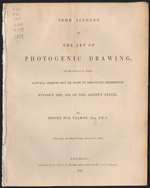 |
Talbot’s First Photographic Publication [zoom] William Henry Fox Talbot. Some Account of the Art of Photogenic Drawing or the Process by Which Natural Objects May be Made to Delineate Themselves Without the Aid of the Artist’s Pencil. London: R. and J. E. Taylor, 1839. Talbot (1800-1877) was the first of the early experimenters in photography to propose, in this paper, a fundamental principle of modern photography: the use of a negative image to produce an unlimited number of positive copies. That same year, Daguerre announced the daguerreotype photographic process. Rushed into print in response to Daguerre’s announcement, Talbot’s publication was premature. His “photogenic drawings” faded and were much inferior to daguerreotype images. Two years later, however, in 1841, Talbot announced the invention of the calotype, a marked improvement on the process. |
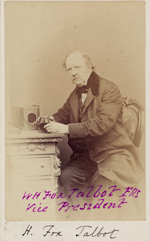 |
John Moffat. William Henry Fox Talbot, 1864. [zoom] Albumen print, carte de visite mount |
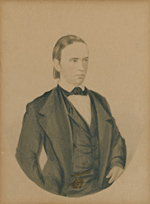 |
Frederick & William Langenheim. Calotype, ca. 1849. [zoom] Hand-colored salted paper print (calotype), 5 7/8 x 4 3/8 in. In 1849 the Langenheim Brothers of Philadelphia secured the American patent rights for Talbot’s process and originated the use of paper photography in the United States. Calotype images lacked fine detail, however, making the process unsuitable for portraits. The daguerreotype remained the dominant form, and as a result early American photographic portraits on paper are extremely rare. On loan from the Stephan and Beth Loewentheil Family Photographic Collection. |
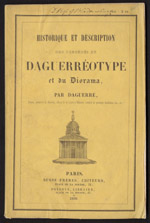 |
Daguerre’s First Manual [zoom] Louis Jacques Mandé Daquerre. Historique et Description des Procedes du Daguerreotype et du Diormama. Paris: Susse Frères, 1839. Daguerre’s Manual, as it is usually called, appeared in September 1839. The book contains a discussion of the genesis of photography and a fully illustrated account of the daguerreotype process. |
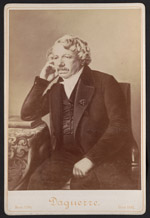 |
G. Cramer, Dry Plate Works. Tribute to Daguerre on the 50th Anniversary of the Invention of Photography, published in 1889. [zoom] Albumen print, cabinet card mount This is a photograph of a painting of Daguerre (1787-1851). The painting in turn was based on a daguerreotype by Charles R. Meade, ca. 1848. When Daguerre died in 1851, he was greatly mourned by New York daguerreotypists who honored him by wearing black crepe on their left sleeves for thirty days. |
 |
Unidentified. Early Daguerreotype, ca. 1845. [zoom] Daguerreotype, sixth plate While a sitter’s clothing, props, and jewelry are useful in dating a photograph, the object itself often provides vital clues. This daguerreotype’s case has a plain mat without engraving and lacks a preserver, indicating a date within the first seven years of the art. |
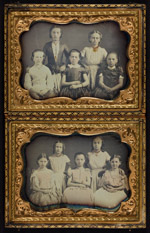 |
Unidentified. Later Daguerreotype, ca. 1855. [zoom] Two hand-tinted daguerreotypes, quarter plate This double-cased pair of portraits dates to the mid 1850s, as indicated by the clothing, hairstyles, the elaborately engraved mat and preserver (which came into use about 1847). The names of the sitters are written on slips of paper tucked beneath the daguerreotype, a common practice for recording the photographer’s credit or information about the photograph. |
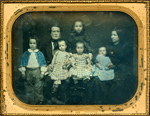 |
Anson, Rufus P. Family of Seven, ca. 1854. [zoom] Hand-tinted daguerreotype, whole plate New York’s Broadway was known for its photographic establishments; with fifteen photographers, Anson’s was one of the largest. One observer wrote, “Anson's gallery is decidedly superior. It is most tasteful in its arrangement, and great order and cleanliness are preserved throughout. The specimens all show the artist’s hand. This gallery deserves the most liberal patronage.” |